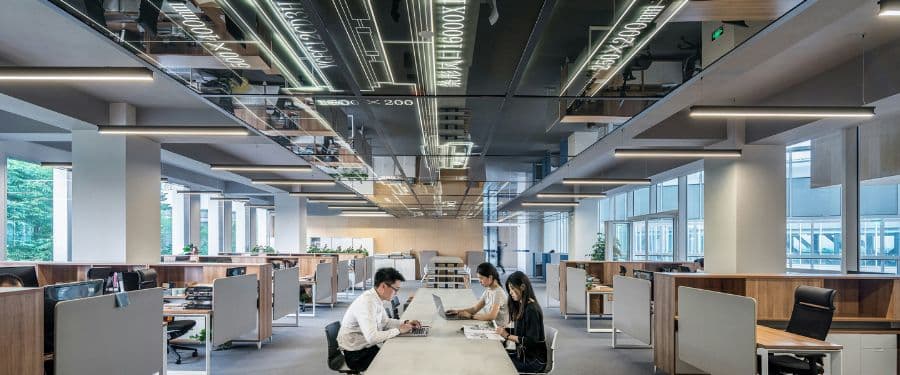Neighborhood Planning with Occupancy Data

VergeSense is the industry leader in providing enterprises with a true understanding of their occupancy and how their offices are actually being used.
Understanding how different groups work is essential for creating effective and efficient workplaces. Yet many organizations find their current space mix doesn't align with their teams' diverse needs and workstyles. This misalignment leads to wasted space and also squanders valuable resources.
According to the latest Occupancy Intelligence Index, 71% of the global space mix is dedicated to desks. However, collaboration spaces like meeting rooms are much more popular among employees, being used 20.6% of the time vs 8.4% for desks.
This data underscores the need for better neighborhood planning — the process of planning space configurations and seating ratios that keep employees productive, collaborative, and inspired when they’re in the office. To successfully plan neighborhoods though, every organization needs occupancy data. Occupancy data helps workplace leaders identify space shortages and when spaces are being underutilized. This allows them to build neighborhoods that fit their teams’ size and needs, as well as:
- Identify the most popular space type in your office.
- Identify the least popular space type in your office.
- Discover where you can improve your workplace design.
But where do you start with incorporating occupancy data into neighborhood planning? In this blog,
we’ll explore three ways VergeSense customers are using this type of data to optimize spaces to align with current and future workplace needs. Let’s get started.

Optimizing Spaces with Occupancy Data
1. Respond to Space Requests
Teams are quick to speak up when they’re running out of space, and their productivity is being compromised. However, their feedback, while valuable, may not always align with factual data.
Occupancy data helps workplace leaders to confidently approve or deny employees’ requests for more space. It offers organizations a scientific approach to neighborhood planning, giving them the power to make decisions both reactively and proactively.
Real-life Example: Customer uses VergeSense to save $1.5M in potential buildout costs. Leveraging the Occupancy Intelligence Platform, they:
- Confidently denied an employee’s space request using occupancy data to validate that they had enough conference rooms, even at peak capacity.
- Saved $1.5M in potential buildout costs using space usage data.
- Developed a scientific system for proactively monitoring space usage and evaluating space requests. Our Usage Maps help customers understand how groups utilize space, and empower them to make data-driven space, amenities, or policy changes.
2. Recognize and Eliminate Space Shortages
Space shortages in the workplace can be a source of frustration and can significantly impact productivity. This issue commonly arises in conference rooms, which tend to be too big for the number of people that actually use them. An effective solution is to repurpose them into smaller collaboration spaces. However, demonstrating the value of this requires concrete data.
The Space Usage Timeline allows occupancy planners to easily identify when a space is at capacity, so they know where and when they need more space. This also makes it possible to confidently validate or negate space requests based on actual space usage data.
Real-life Example: VergeSense customer uses space usage data to uncover unique space utilization dynamics within the office. Using VergeSense, they:
- Leveraged space usage data to investigate a perceived conference room shortage. The customer uncovered an interesting trend: when conference room usage reached 70%, employees consistently reacted negatively, signaling a space shortage.
- Transformed their decision-making process, using occupancy data to anticipate and address space shortages before they impact productivity.
- Embraced a data-driven approach to neighborhood planning, optimizing their workspace to better meet the needs of their teams.
3. Identify and Make Decisions About Unused Space
Once a space shortage is identified, the next crucial step is to devise solutions to address it effectively. Repurposing unused space is one strategy our customers use to alleviate shortages and optimize workspace utilization.
Occupancy data powers this solution. Using it, workplace leaders can gain valuable insights into space utilization patterns within their workplace. This data empowers them to pinpoint areas that are underused or vacant, providing an opportunity to repurpose them in alignment with their teams' needs.
By leveraging occupancy data to identify and make decisions about unused space, every organization can maximize the efficiency of its workspace, ensuring that every square foot contributes to productivity and supports the diverse activities of teams.
Real-life Example: Global pharmaceutical company uses occupancy data from VergeSense to design the perfect workplace for its employees’ needs. Using the Occupancy Intelligence Platform, they:
- Used actual space utilization data to confirm observations about low conference room usage, giving them the confidence to repurpose underutilized spaces to build a bigger lobby.
- Enhanced the overall employee experience by designing a workplace their teams actually wanted and used effectively.
Simplify Neighborhood Planning With Occupancy Data
At VergeSense, we’re proud to streamline the neighborhood planning process for our customers by providing comprehensive occupancy data that allows them to make confident decisions. With our single platform for occupancy intelligence, customers can make comprehensive decisions with occupancy, wifi, and other data sources.
From identifying space shortages to recognizing underutilized areas, the Occupancy Intelligence Platform empowers workplace leaders and occupancy planners to make informed decisions that align with their teams' needs and behaviors.
As we've explored throughout this blog, occupancy data serves as a catalyst for proactive decision-making, enabling organizations of all sizes to optimize their workspace effectively. By leveraging this data, workplace leaders can unlock a wealth of opportunities to enhance space availability, reduce costs, and elevate the employee experience.
Let’s recap what we’ve learned about the power of occupancy data for neighborhood planning:
- Occupancy data can identify space shortages, enabling organizations to respond promptly and confidently.
- Utilizing occupancy intelligence, organizations can recognize and repurpose unused space, maximizing the efficiency of their workspace.
- VergeSense empowers organizations to develop a scientific system for monitoring space usage and evaluating space requests proactively.
- By embracing a data-driven approach to neighborhood planning, organizations can achieve tangible benefits, including improved space availability, reduced costs, and enhanced employee satisfaction.
Want to learn more about Neighborhood Planning? Watch our webinar from April 9.